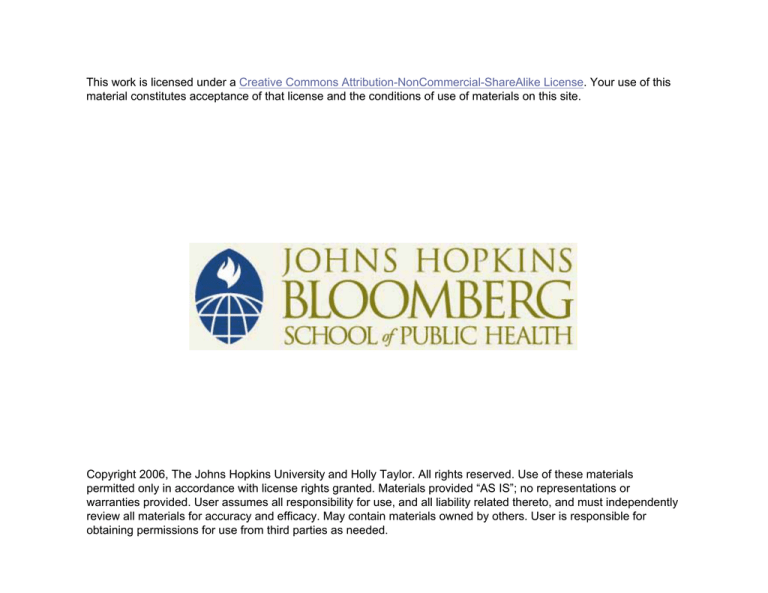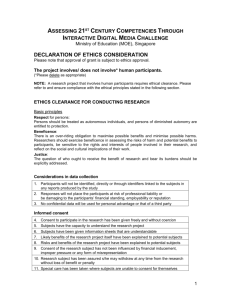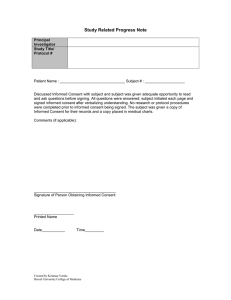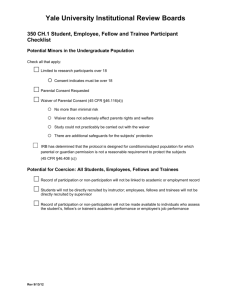
This work is licensed under a Creative Commons Attribution-NonCommercial-ShareAlike License. Your use of this
material constitutes acceptance of that license and the conditions of use of materials on this site.
Copyright 2006, The Johns Hopkins University and Holly Taylor. All rights reserved. Use of these materials
permitted only in accordance with license rights granted. Materials provided “AS IS”; no representations or
warranties provided. User assumes all responsibility for use, and all liability related thereto, and must independently
review all materials for accuracy and efficacy. May contain materials owned by others. User is responsible for
obtaining permissions for use from third parties as needed.
Assessment of Risks and
Benefits
Holly Taylor, MPH, PhD
Johns Hopkins University
Framework for Ethical Analysis
Beneficence
– Moral requirements
• Do no harm
• Maximize benefits/minimize harms
– Practical applications
• Study design
• Assessment of risks and benefits
3
Topics to be Covered
Principle of beneficence
Study design
– What is research?
Assessment of risks and benefits
– Risks
– Benefits
– Balancing
4
Section A
Principle of Beneficence
Definition/Theory
Central to health professions
Different views of beneficence
– Frankena
– Beauchamp and Childress
Continued
6
Definition/Theory
Beauchamp and Childress formulation
Continued
7
Definition/Theory
Principle of utility
– Beneficence at core
– Maximizing principle
Ethic of care
– Relationships
8
Principle of Beneficence
Applied to research ethics
– Study design
9
Section B
What is Research?
What is Research?
“Research—a systematic investigation
including research development, testing, and
evaluation designed to contribute to
generalizable knowledge.”
Source: 45 CFR § 46.102 (e)
Continued
11
What is Research?
“Human subject—a living individual about
whom an investigator conducting research
obtains . . .
– (1) data through intervention or
interaction with the individual, or
– (2) identifiable private information.”
Source: 45 CFR § 46.102 (f)
Continued
12
What is Research?
Distinguishing research from practice
13
Research vs. Practice
1. What is the goal of the investigator?
– Local or generalizable
2. Is there intent to publish the results?
– Journal requirements
Continued
14
Research vs. Practice
3. How did the investigator come to
know/interact with the patient/client?
– Stranger?
4. Will usual care be changed or manipulated?
Continued
15
Research vs. Practice
5. How novel is the care or intervention?
– Does it deviate from standard practice?
6. Will there be systematic data collection?
16
Research vs. Quality Assurance
Criteria 1
– “Initiative should be regulated by research
regulations if the majority of patients are
not expected to benefit directly from the
knowledge to be gained.”
Source: Casarett, Karlawish, Sugarman. JAMA, 2000, 283
(17): 2275-80
Continued
17
Research vs. Quality Assurance
Criteria 2
– “If the majority of patients are likely to
benefit from knowledge to be gained,
initiative should be reviewed and
regulated as research if participants would
be subjected to additional risks or burdens
beyond the usual clinical practice to make
its results generalizable.”
Source: Casarett, Karlawish, Sugarman (2000). JAMA, 283 (17):
2275-80
Continued
18
Research vs. Quality Assurance
Source: Casarett, Karlawish, Sugarman. JAMA 2000 283 (17):
2275-80)
19
Research?
If activity is determined to be research:
– Federal guidelines apply
– Must be reviewed by an IRB
20
Section C
Assessment of Risks and Benefits
IRB Responsibility
Risks to subjects are minimized
Risks to subjects are reasonable in relation to
the anticipated benefits, if any, to subjects,
and the importance of the knowledge that
may be reasonably be expected to result
Source: 45 CFR § 46.111
22
Risk Concepts
Risk—probability and magnitude of some
future occurrence of harm
Harm—injury, setback to interests
Risk assessment
Continued
23
Risk Concepts
Continued
24
Risk Concepts
Uncertainty—lack of predictability
Risk perception—perceptions based on
personal experience/attitudes/psychology
Relative risk
Continued
25
Risk Concepts
Minimal risk—“Minimal risk means that the
probability and magnitude of harm or
discomfort anticipated in the research is not
greater in and of itself than those
encountered during daily life or during the
performance of routine physical and
psychological examinations or tests.”
Source: 45 CFR 46.102(I)
Continued
26
Risk Concepts
Minimal Risk
Implications for . . .
– Consent
– Enrollment of vulnerable populations
Continued
27
Risk Concepts
Minimal Risk
Therapeutic vs. non-therapeutic
28
Individual Risk
Physical
– Bodily injury
– Healthy volunteer vs. patient
– Early testing
– Delay
– Related to RCT
Continued
29
Individual Risk
Psychological
– Stress, discomfort
– Disclosure of medical information
– Deception
Continued
30
Used with permission of New Life Community Church of Stafford:
http://www.new-life.net/milgram.htm
31
Milgram Experiment
“I observed a mature and initially poised
businessman enter the laboratory smiling
and confident. Within 20 minutes he was
reduced to a twitching, stuttering wreck,
who was rapidly approaching a point of
nervous collapse.”
Source: Faden and Beauchamp (1986). A History and Theory of Informed Consent
32
Individual Risk
Inconvenience
Wrongs to personhood
Continued
33
Individual Risk
Individual Risk—Social Risks
Risks to reputation/stigma
– Breaches of confidentiality
Economic
34
Community Risk
Readings
“Community”
– Ethnic/tribal
– Immigrants
– Marginalized group
– Minority group
– Extended family
– Religious group
Continued
35
Community Risk
Community Risk—Social Risks
Stigma
Economic
Exploitation
36
Section D
Benefits
Benefits
Concept
– Something of value related to
health/welfare
38
Possible Benefits
Individual Benefit
Physical
– Medical
– “Inclusion” Benefit
• Lantos
• Peppercorn, et al.
39
Individual Benefit
Psychological
– Hope
– Altruism
Kinship
Social
40
Individual Benefit
Economic
– Access to medical care
– Monetary
41
Possible Benefits
Financial Compensation
Concerns
Source: Dickert and Grady (1999). NEJM 341(3): 198-203
Continued
42
Possible Benefits
Financial Compensation
Models
– Market
– Wage-payment
– Reimbursement
Source: Dickert and Grady (1999). NEJM 341(3): 198-203
43
Benefits
Community Benefit
– Medical
– Material
44
Balancing Risks and Benefits
Goals
– Minimize risk
– Maximize benefit
45
Section E
Case Example: Research in the
Emergency Room
Research in ER
Will patients with severe head trauma
benefit from anti-oxidant therapy?
Investigators wish to study whether the drug
polyethlyene glycol-superoxide dismutase (PEGSOD) will limit the degree of brain injury
suffered by head trauma patients
To date, data from animal models and limited
human trials demonstrate a possible benefit
Source: Karlawish and Hall (1996). Am J Respir Crit Care
Med, 153: 499-5-6
Continued
47
Research in ER
The study design will randomize patients to
receive either one of two possible doses of
PEG-SOD or placebo
Given the circumstances of the patients’
injuries, they are typically unable to give
informed consent
Source: Karlawish and Hall (1996). Am J Respir Crit Care
Med, 153: 499-5-6
Continued
48
Research in ER
Furthermore, if the patients are to benefit
from PEG-SOD, the investigators must
administer the drug expeditiously, within two
hours of presentation to hospital
Source: Karlawish and Hall (1996). Am J Respir Crit Care
Med, 153: 499-5-6
Continued
49
Research in ER
Consider risks and benefits
– Individual
– Group
Continued
50
Research in ER
Consider alternative methods of consent
– Surrogate
– Deferred
– Waiver
Continued
51
Research in ER
Consider alternative methods of consent
– 1996 waiver
• Life threatening situation
• Available treatment unproven
• Valid scientific data necessary
Continued
52
Research in ER
Consider alternative methods of consent
– 1996 waiver
• Obtaining consent not feasible
• Participation holds out potential for
direct benefit
• Research could not be carried out
without waiver
Continued
53
Research in ER
Consider alternative methods of consent
– 1996 waiver
• Investigator will try and reach decisionmaker
• IRB approved
• Protections
• Subject notified ASAP
54






